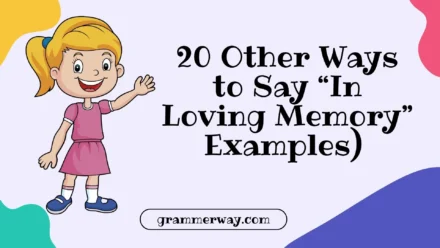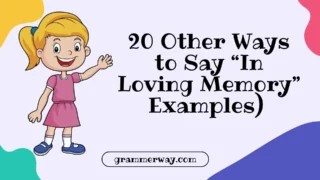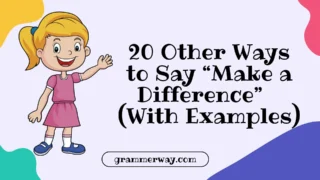Finding the right words to express that something isn’t good can make all the difference in how your message is received. Whether you’re giving feedback, reacting to bad news, or trying to express disappointment kindly, knowing empathetic and thoughtful alternatives to “That’s not good” helps you sound more caring, professional, and emotionally intelligent. These phrases allow you to communicate concern without sounding too harsh, judgmental, or negative — helping your message feel more personal and understanding.
What Does “That’s Not Good” Mean?
The phrase “That’s not good” is often used when reacting to something unpleasant, disappointing, or undesirable. It expresses disapproval or concern, but it can sometimes sound too blunt or unempathetic. Using warmer alternatives helps you acknowledge a situation without discouraging others or sounding insensitive.
Is It Professional or Polite to Say “That’s Not Good”?
While saying “That’s not good” is not rude, it may come across as vague or negative in professional or emotional settings. A better approach is to use gentler, more specific phrases that show understanding, such as “That sounds challenging” or “I can see why that’s upsetting.” These alternatives make your communication sound respectful, supportive, and emotionally aware — essential traits in both personal and professional interactions.
Synonyms For “That’s Not Good”
- That sounds difficult
- That doesn’t sound ideal
- That must be frustrating
- That’s unfortunate
- That’s really tough
- That’s disappointing
- That doesn’t sound great
- That’s not ideal
- That’s concerning
- That’s unfortunate news
- That’s not the best situation
- That could be better
- That’s a bit worrying
- That’s not what I hoped for
- That’s a tough spot to be in
- That’s not what we wanted
- That’s not looking great
- That’s not encouraging
- That’s hard to hear
- That’s not what I expected
1. That Sounds Difficult
Scenario: When someone shares a problem or struggle.
Meaning: You recognize that the situation is tough without judging or dismissing it.
Examples:
- That sounds difficult — how are you managing everything right now?
- I can imagine that must feel really tough to deal with.
- That sounds difficult; I’m sorry you’re going through that.
- It really sounds like a challenging time for you.
- That sounds difficult — I’m here if you need someone to talk to.
Tone: Empathetic and supportive.
Explanation: This phrase focuses on the person’s feelings rather than the situation itself. It shows compassion and emotional awareness, which is comforting in both personal and professional situations.
2. That Doesn’t Sound Ideal
Scenario: When something isn’t disastrous but still not great.
Meaning: You acknowledge imperfection in a polite and professional way.
Examples:
- That doesn’t sound ideal, but maybe we can find a solution.
- Hmm, that doesn’t sound ideal — let’s look into it.
- It seems like that didn’t go as planned.
- That doesn’t sound ideal, but I’m sure there’s room to improve.
- It doesn’t sound ideal, yet it’s something we can work on together.
Tone: Neutral and constructive.
Explanation: This phrase works well in workplace conversations because it avoids sounding harsh. It invites collaboration and focuses on problem-solving, not blame.
3. That Must Be Frustrating
Scenario: When someone expresses irritation or disappointment.
Meaning: You acknowledge and validate their emotions.
Examples:
- That must be frustrating — you’ve put so much effort into it.
- I can tell that situation really tested your patience.
- That must be frustrating; I totally understand why you feel that way.
- You’ve been working hard, so I can imagine how upsetting that feels.
- That must be frustrating, but your reaction makes perfect sense.
Tone: Kind and validating.
Explanation: This phrase helps people feel heard and understood. Instead of judging the situation, it emphasizes empathy and support.
4. That’s Unfortunate
Scenario: When reacting to bad news or disappointment.
Meaning: A polite way to express sympathy or mild regret.
Examples:
- That’s unfortunate — I hope things improve soon.
- That’s unfortunate to hear; is there any way I can help?
- It’s unfortunate, but sometimes these things happen.
- That’s unfortunate — let’s see how we can fix it.
- That’s unfortunate; I’m sorry you’re dealing with that.
Tone: Polite and professional.
Explanation: It’s a neutral and tactful alternative that works well in both formal and personal settings without being too emotional or distant.
5. That’s Really Tough
Scenario: When someone faces emotional or practical hardship.
Meaning: Acknowledges the difficulty and emotional weight of a situation.
Examples:
- That’s really tough; I can’t imagine how you’re feeling.
- That’s tough — you’ve been handling it so well.
- It’s really tough to be in that position.
- That’s really tough; I admire your strength.
- That sounds really tough — take things one step at a time.
Tone: Compassionate and sincere.
Explanation: It conveys genuine concern and understanding, ideal for emotional conversations.
6. That’s Disappointing
Scenario: When something didn’t meet expectations.
Meaning: Expresses regret without harsh criticism.
Examples:
- That’s disappointing — I know you were hoping for a better outcome.
- It’s disappointing, but there’s still time to turn things around.
- That’s disappointing — we’ll take it as a learning experience.
- That’s disappointing; it’s okay to feel let down.
- It’s disappointing, yet not the end of the world.
Tone: Supportive and understanding.
Explanation: This phrase helps you share empathy while maintaining a positive and balanced outlook.
7. That Doesn’t Sound Great
Scenario: When reacting to unpleasant but minor news.
Meaning: Indicates mild concern or disapproval.
Examples:
- That doesn’t sound great — are you okay?
- Hmm, that doesn’t sound great; maybe things will get better.
- That doesn’t sound great; I hope it improves soon.
- It doesn’t sound great, but at least you’re aware of it now.
- That doesn’t sound great — let’s try to fix it together.
Tone: Friendly and casual.
Explanation: This version of “That’s not good” sounds softer and more conversational, suitable for informal settings.
8. That’s Not Ideal
Scenario: When something doesn’t go according to plan.
Meaning: A professional and calm way to express dissatisfaction.
Examples:
- That’s not ideal — let’s find a better solution.
- It’s not ideal, but we can make it work.
- That’s not ideal; I’ll make sure it doesn’t happen again.
- It’s not ideal, yet it’s manageable for now.
- That’s not ideal — we can learn from it.
Tone: Diplomatic and constructive.
Explanation: This phrase maintains professionalism while recognizing imperfection or inconvenience.
9. That’s Concerning
Scenario: When discussing something potentially serious.
Meaning: Indicates awareness of a problem that may need attention.
Examples:
- That’s concerning — we should investigate further.
- That’s concerning; thank you for bringing it up.
- It’s concerning, but we can still find a solution.
- That’s concerning; let’s take quick action.
- That’s concerning — I’ll make sure we address it properly.
Tone: Professional and serious.
Explanation: Use this when you need to communicate importance or urgency without sounding emotional.
10. That’s Unfortunate News
Scenario: When responding to disappointing updates or setbacks.
Meaning: A sympathetic and gentle way to acknowledge that something hasn’t gone as hoped.
Examples:
- That’s unfortunate news — I’m really sorry to hear that.
- That’s unfortunate news; I know how much this meant to you.
- That’s unfortunate news, but I believe something better will come along.
- It’s unfortunate news — I wish the outcome had been different.
- That’s unfortunate news; I hope things turn around soon.
Tone: Compassionate and considerate.
Explanation: This phrase is empathetic but composed, ideal for formal or emotional conversations where you want to show care without overreacting.
11. That’s Not the Best Situation
Scenario: When something goes wrong, but you want to remain positive.
Meaning: A mild and understanding way to say things could be better.
Examples:
- That’s not the best situation, but we can work with it.
- It’s not the best situation, though it’s still manageable.
- That’s not the best situation — let’s figure out a way forward.
- That’s not the best situation, but you’ve handled it well.
- It’s not the best situation, yet it’s not hopeless either.
Tone: Balanced and encouraging.
Explanation: This phrase communicates realism with optimism. It works perfectly when you want to be honest but motivating.
12. That Could Be Better
Scenario: When offering gentle feedback or commentary.
Meaning: Suggests room for improvement without harshness.
Examples:
- That could be better — let’s refine it a little more.
- Hmm, that could be better; maybe we can adjust the details.
- It could be better, but it’s a solid start.
- That could be better — I see potential in it.
- It could be better; let’s brainstorm improvements together.
Tone: Constructive and friendly.
Explanation: This is a positive, growth-oriented phrase that helps motivate rather than discourage. Perfect for feedback conversations at work.
13. That’s a Bit Worrying
Scenario: When something feels potentially problematic.
Meaning: Expresses gentle concern about an issue or situation.
Examples:
- That’s a bit worrying — let’s keep an eye on it.
- That’s a bit worrying; should we look into it further?
- It’s a bit worrying, though not completely unexpected.
- That’s a bit worrying — I think we should take precautions.
- It’s a bit worrying, but we can handle it with care.
Tone: Calm but cautious.
Explanation: This phrase allows you to address problems sensitively while avoiding panic or criticism.
14. That’s Not What I Hoped For
Scenario: When something doesn’t meet your expectations.
Meaning: A personal and honest way to express mild disappointment.
Examples:
- That’s not what I hoped for, but I appreciate your effort.
- That’s not what I hoped for, though it’s still valuable.
- It’s not what I hoped for, yet it’s a good start.
- That’s not quite what I hoped for — let’s adjust it slightly.
- It’s not what I hoped for, but it’s okay; we’ll get there.
Tone: Respectful and honest.
Explanation: This is a diplomatic phrase for personal feedback or gentle disappointment, maintaining kindness and clarity.
15. That’s a Tough Spot to Be In
Scenario: When someone is facing a difficult decision or challenge.
Meaning: Shows understanding and empathy for their situation.
Examples:
- That’s a tough spot to be in — I can understand how you feel.
- You’re in a tough spot; let’s think through it together.
- That’s a tough spot to be in, but you’re handling it well.
- That’s really a tough spot — take your time before deciding.
- You’re in a tough spot, but I know you’ll figure it out.
Tone: Supportive and empathetic.
Explanation: This phrase recognizes difficulty without judgment, helping the other person feel seen and supported.
16. That’s Not What We Wanted
Scenario: When results don’t match expectations.
Meaning: Expresses collective disappointment while staying professional.
Examples:
- That’s not what we wanted, but it’s a learning opportunity.
- That’s not what we wanted — we’ll try a different approach next time.
- It’s not what we wanted, though it’s not a total loss.
- That’s not what we wanted, but progress still counts.
- It’s not what we wanted; let’s focus on what we can fix.
Tone: Objective and forward-looking.
Explanation: This phrase keeps focus on teamwork and improvement rather than failure, ideal for workplace feedback.
17. That’s Not Looking Great
Scenario: When discussing ongoing challenges or results.
Meaning: A casual but honest way to express mild concern.
Examples:
- That’s not looking great — maybe we should reevaluate our plan.
- Hmm, that’s not looking great; can we adjust it?
- That’s not looking great, but we can still turn it around.
- That’s not looking great right now — let’s check what went wrong.
- It’s not looking great, but it’s not too late to fix it.
Tone: Candid yet supportive.
Explanation: Best used in informal or collaborative settings, this phrase strikes a balance between realism and positivity.
18. That’s Not Encouraging
Scenario: When you want to express disappointment in a measured, polite way.
Meaning: Indicates that something isn’t promising or uplifting.
Examples:
- That’s not encouraging — what can we do differently?
- It’s not encouraging, but it’s worth trying again.
- That’s not encouraging; let’s dig into the cause.
- That’s not encouraging news — we’ll need a new approach.
- It’s not encouraging, though it’s not a total setback.
Tone: Calm and analytical.
Explanation: This phrase works well for reports, updates, or feedback, where you want to express concern without sounding emotional.
19. That’s Hard to Hear
Scenario: When someone shares emotional or painful information.
Meaning: Expresses compassion and empathy for another person’s difficult situation.
Examples:
- That’s hard to hear — I’m really sorry you’re dealing with that.
- That’s hard to hear; I can imagine how upsetting that must be.
- It’s hard to hear, but I appreciate your honesty.
- That’s hard to hear — I’m here if you need support.
- That’s hard to hear; you’ve been through so much already.
Tone: Gentle and compassionate.
Explanation: This phrase helps you acknowledge pain with sincerity, making the other person feel comforted and respected.
20. That’s Not What I Expected
Scenario: When results or situations differ from your assumptions.
Meaning: Communicates surprise or mild disappointment politely.
Examples:
- That’s not what I expected, but I appreciate the update.
- It’s not what I expected — let’s explore why it happened.
- That’s not what I expected; it’s interesting how things turned out.
- It’s not what I expected, but I’m open to seeing the positive side.
- That’s not what I expected, though it might work in our favor later.
Tone: Neutral and reflective.
Explanation: This phrase maintains grace and curiosity, keeping communication open and emotionally balanced.
Conclusion
Finding other ways to say “That’s not good” can completely change the tone of your message. By choosing empathetic, thoughtful, and positive phrasing, you not only express your feelings clearly but also show kindness and professionalism. Words have power — and using them wisely helps you connect with others more meaningfully and respectfully.
FAQs:
1. Why should I avoid saying “That’s not good” directly?
Because it can sound blunt or discouraging, even when you don’t mean it that way. Softer alternatives help maintain positive communication.
2. Which alternative is best for professional emails?
Phrases like “That’s not ideal”, “That’s concerning”, or “That doesn’t sound ideal” sound polite and constructive in workplace communication.
3. What’s a more empathetic version for emotional conversations?
Try “That must be frustrating” or “That’s hard to hear” — they express care and understanding.
4. Are these alternatives okay for written and spoken use?
Yes, most of them fit both. Just adjust your tone — formal for work, casual for personal chats.
5. Can using softer phrases make me sound weak?
Not at all! It actually makes you sound emotionally intelligent and thoughtful, which strengthens your communication.







Leave a Comment